There have been many strange tales about ships, sailors and the sea, but perhaps none quite as puzzling as the true-life story of the mysterious ghost ship Mary Celeste. This strange case baffled the world when it occurred in 1872, and we are no closer to understanding it today. The Mary Celeste remains a mystery, with secrets the ocean has never revealed.
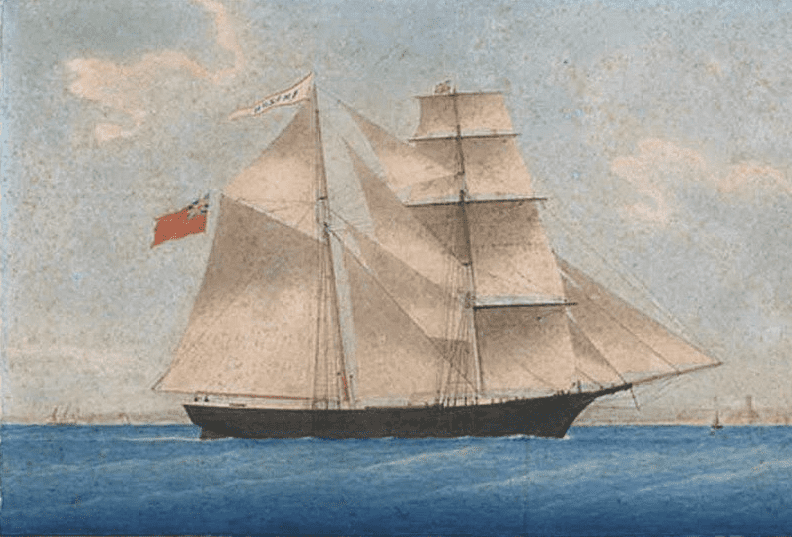
This much is known. On 5 November 1872, the merchant ship Mary Celeste took on a cargo of 1,701 barrels of alcohol in New York City for Meissner Ackermann & Co. The alcohol was to be transported to Genoa, Italy, for use in strengthening Italian wines. The ship was seaworthy with an experienced captain and capable crew.
The Mary Celeste sailed out of Staten Island, New York. One month later it was discovered, under sail and in good shape, off the coast of southern Portugal – completely deserted. All ten people aboard had vanished without any sign of violence or struggle, and were never heard from again. What happened to them, and how the ship managed to sail merrily along for almost ten days without any crew, are enduring mysteries.
The captain of the Mary Celeste was Benjamin S. Briggs, who came from a seafaring family and had commanded other ships and made many successful voyages. He was known as a fair, pleasant man who was always appreciated by his crews. He was also a deeply religious man and a teetotaler.
On this fateful trip, the captain was accompanied by his wife Sarah (who had made several other voyages with him) and their two-year-old daughter Sophia. Because of school, the couple left their seven-year-old son Arthur behind in Marion, Massachusetts, with the captain’s mother. The other seven people on board were the crew: two Americans, one Dane, and four Germans, all with solid reputations who spoke good English.
The weather during their crossing of the Atlantic was fine, the crew harmonious and competent, the captain experienced and a good man to have in charge of a cargo of alcohol. Nothing should have gone wrong on this trip. And yet something terrible did…
On 4 December 1872, the Mary Celeste was discovered by a passing ship, the Dei Gratia, heading toward the Strait of Gibraltar under sail and in fine, if somewhat disheveled, seaworthy condition. After observing the Mary Celeste for two hours without seeing signs of anyone on board, men from the Dei Gratia boarded the other ship and found it deserted. Everything else they found only deepened the mystery.

There were no signs of a violent struggle and the ship was not flying a distress signal. The cargo was intact, and there were personal belongings and valuables left in the cabins. The captain’s watch was found hanging by his bed. The ship still had six months’ supply of water and food. However, the lifeboat was gone, and all the ship’s papers – except for the captain’s log, which recorded nothing unusual – were missing. A rope was fastened to the end of the ship, whose frayed end was found trailing behind in the water.
The captain of the Dei Gratia, David Reed Morehouse, ordered some of his men to sail the Mary Celeste to Gibraltar to be claimed as salvage. Because of the suspicious circumstances, a three-month inquiry was made by the Vice Admiralty Court – but in the end the crew of the Dei Gratia was cleared of any wrongdoing and granted a salvage award. As to what happened to the Mary Celeste and its missing crew, no answers could be found.
Newspapers were rife with speculation, as can be seen in the following four articles. There were three main rumors, but none of them withstands careful scrutiny.
One rumor was that the Mary Celeste had been overcome by pirates. However, what were originally thought to be drops of blood were shown by scientific tests to actually be rust stains. What is most convincing in debunking the pirate theory is this: there were no signs of a struggle, the cargo of alcohol was untouched, and valuables were left in the cabins. Can you possibly imagine pirates capturing a ship crammed with barrels of alcohol, with many valuables in the cabins, and not taking anything? The Mary Celeste would have been a dream prize for any pirate, and we can safely assume it was not captured by buccaneers.
The second rumor is that a mutiny occurred on board the Mary Celeste, but, again, the lack of any sign of a struggle seems to rule this out. Additionally, the reputations of the captain and crew make it almost a certainty there was no mutiny.
The third rumor was that the Mary Celeste was the victim of an insurance fraud, but this seems as implausible as the other two rumors. It is inconceivable that Captain Briggs, a man of sterling reputation, would go along with any such scheme – especially one that entailed abandoning his ship and forcing his wife and little girl to face the dangers of the sea in a lifeboat. Briggs also wrote his mother a letter shortly before the Mary Celeste departed, speaking optimistically of the voyage ahead and expressing his strong desire to see her and his little boy when the ship returned in the spring. Hardly the background for a man planning to commit a half-baked and dangerous insurance fraud.
In recent times a theory has been proposed that, at first, seems plausible – but does not stand up to scrutiny any better than the 1872-1873 rumors. When the cargo was eventually delivered to the owners in Genoa, 9 of the 1,701 barrels were found to be empty. These nine barrels – and only these nine – were made of red oak, a more porous wood than the white oak used in all the other barrels. It has been speculated that the nine barrels leaked, and the crew became alarmed when they smelled the overwhelming vapors and feared an imminent explosion.
According to this theory everyone jumped into the lifeboat, fastened by a strong rope to the stern of the Mary Celeste, to wait for a period of time to see if an explosion would occur. Then for some reason the rope snapped, the lifeboat drifted away, and the Mary Celeste managed to sail on without her crew.
There are two important facts that contradict this theory. For one, when the men of the Dei Gratia entered the hold of the Mary Celeste less than ten days after it was abandoned, they smelled nothing. If the hold was reeking with alcoholic fumes so powerful that Captain Briggs and his crew were convinced an explosion was imminent, a strong smell would still have been prevalent. Especially because of fact number two: the main hatch of the Mary Celeste was still sealed when the ghost ship was discovered. If the crew feared an explosion from the build-up of alcoholic vapors, they would have opened the hatch to let the ship air out while they waited in the safety of the lifeboat. But they did not.
No, reason cannot solve the puzzle of the ghost ship Mary Celeste, for there is no explanation. It remains what it has been since its startling discovery on 4 December 1872: a mystery of the sea.
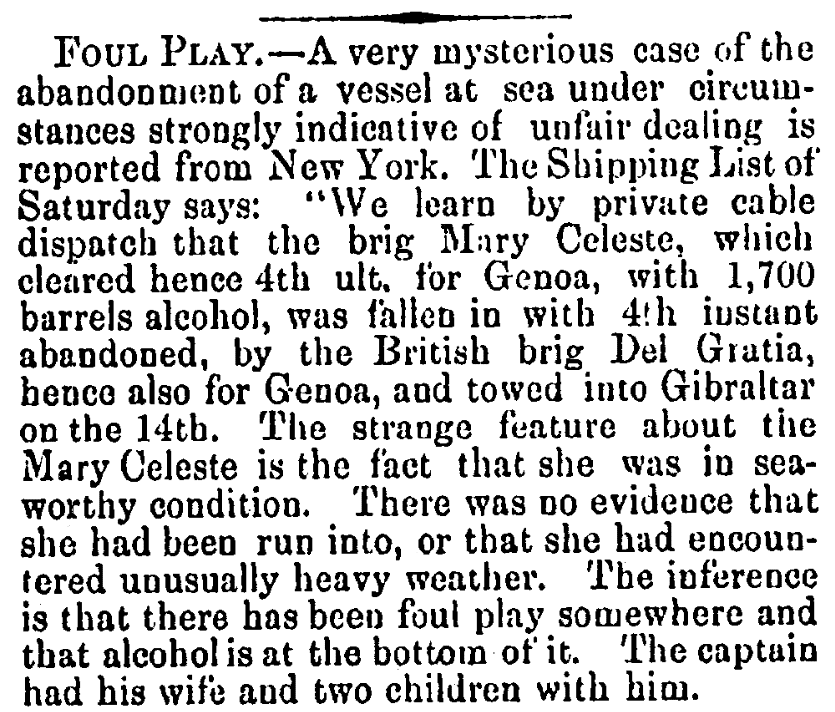
Here is a transcription of this article:
FOUL PLAY. – A very mysterious case of the abandonment of a vessel at sea under circumstances strongly indicative of unfair dealing is reported from New York. The Shipping List of Saturday says: “We learn by private cable dispatch that the brig Mary Celeste, which cleared hence 7th ult. [i.e., November 7] for Genoa, with 1,700 barrels alcohol, was fallen in with 4th instant [i.e., December 4] abandoned, by the British brig Dei Gratia, hence also for Genoa, and towed into Gibraltar on the 14th. The strange feature about the Mary Celeste is the fact that she was in seaworthy condition. There was no evidence that she had been run into, or that she had encountered unusually heavy weather. The inference is that there has been foul play somewhere and that alcohol is at the bottom of it. The captain had his wife and two children [correction: one child] with him.
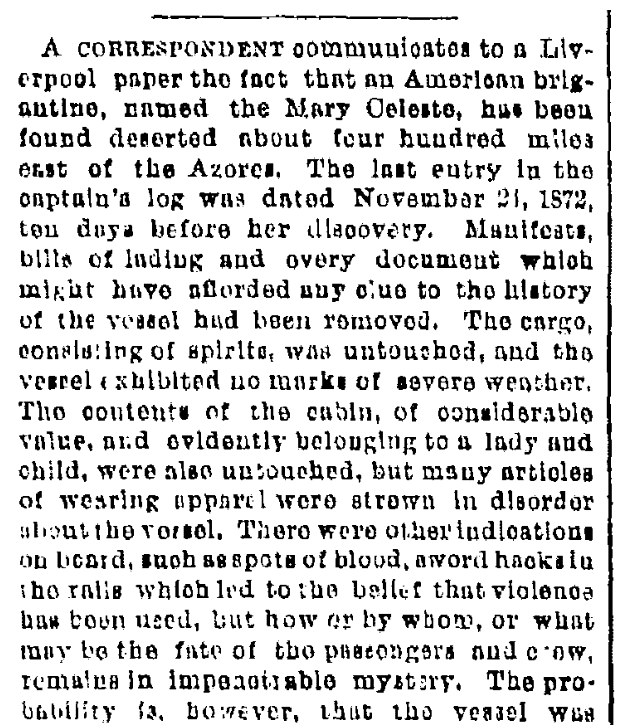
Here is a transcription of this article:
A CORRESPONDENT communicates to a Liverpool paper the fact that an American brigantine, named the Mary Celeste, has been found deserted about four hundred miles east of the Azores. The last entry in the captain’s log was dated November 24, 1872, ten days before her discovery. Manifests, bills of lading and every document which might have afforded any clue to the history of the vessel had been removed. The cargo, consisting of spirits, was untouched, and the vessel exhibited no marks of severe weather. The contents of the cabin, of considerable value, and evidently belonging to a lady and child, were also untouched, but many articles of wearing apparel were strewn in disorder about the vessel. There were other indications on board, such as spots of blood [and] sword hacks in the rails, which led to the belief that violence has been used, but how or by whom, or what may be the fate of the passengers and crew, remains in impenetrable mystery. The probability is, however, that the vessel was seized by pirates, or taken possession of by her crew, and that a terrible deed of blood was done before she was finally abandoned.
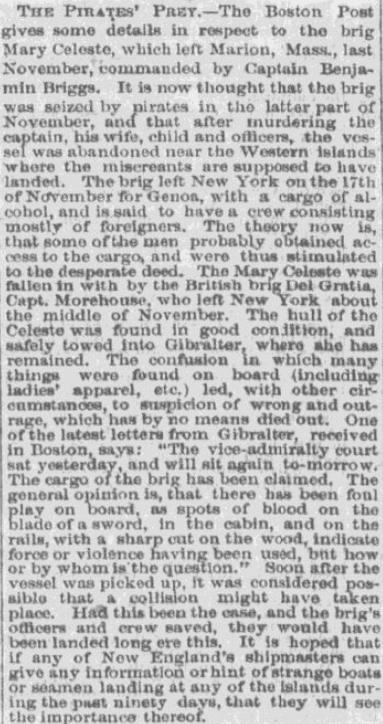
Here is a transcription of this article:
THE PIRATES’ PREY. – The Boston Post gives some details in respect to the brig Mary Celeste, which left Marion, Mass., last November, commanded by Captain Benjamin Briggs. It is now thought that the brig was seized by pirates in the latter part of November, and that after murdering the captain, his wife, child and officers, the vessel was abandoned near the Western islands where the miscreants are supposed to have landed. The brig left New York on the 7th of November for Genoa, with a cargo of alcohol, and is said to have a crew consisting mostly of foreigners. The theory now is, that some of the men probably obtained access to the cargo, and were thus stimulated to the desperate deed. The Mary Celeste was fallen in with by the British brig Dei Gratia, Capt. Morehouse, who left New York about the middle of November. The hull of the Celeste was found in good condition, and safely towed into Gibraltar, where she has remained. The confusion in which many things were found on board (including ladies’ apparel, etc.) led, with other circumstances, to suspicion of wrong and outrage, which has by no means died out. One of the latest letters from Gibraltar, received in Boston, says: “The vice-admiralty court sat yesterday, and will sit again tomorrow. The cargo of the brig has been claimed. The general opinion is that there has been foul play on board, as spots of blood on the blade of a sword, in the cabin, and on the rails, with a sharp cut on the wood, indicate force or violence having been used, but how or by whom is the question.” Soon after the vessel was picked up, it was considered possible that a collision might have taken place. Had this been the case, and the brig’s officers and crew saved, they would have been landed long ere this. It is hoped that if any of New England’s shipmasters can give any information or hint of strange boats or seamen landing at any of the islands during the past ninety days, that they will see the importance thereof.
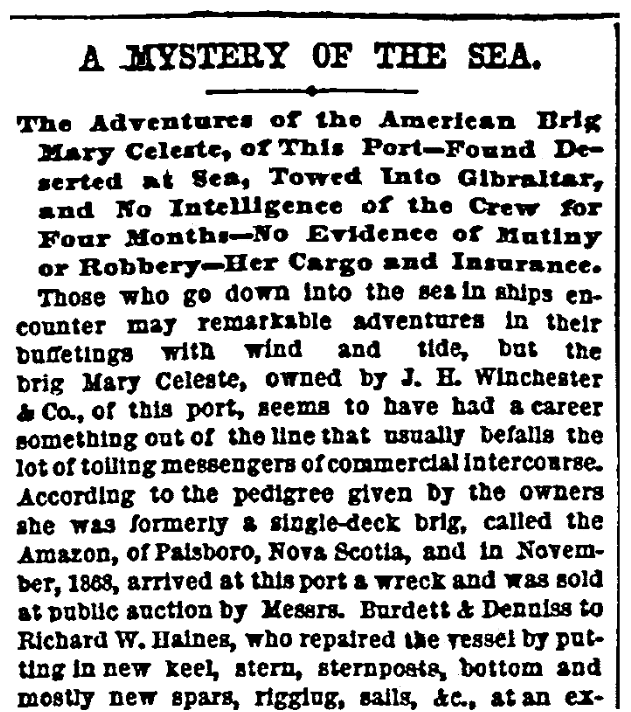
Here is a transcription of this article:
A MYSTERY OF THE SEA.
The Adventures of the American Brig Mary Celeste, of This Port – Found Deserted at Sea, Towed into Gibraltar, and No Intelligence of the Crew for Four Months – No Evidence of Mutiny or Robbery – Her Cargo and Insurance.
Those who go down into the sea in ships encounter many remarkable adventures in their buffetings with wind and tide, but the brig Mary Celeste, owned by J. H. Winchester & Co., of this port, seems to have had a career something out of the line that usually befalls the lot of toiling messengers of commercial intercourse. According to the pedigree given by the owners, she was formerly a single-deck brig, called the Amazon, of Parrsboro, Nova Scotia, and in November 1868, arrived at this port a wreck and was sold at public auction by Messrs. Burdett & Denniss to Richard W. Haines, who repaired the vessel by putting in new keel, stern, sternposts, bottom and mostly new spars, rigging, sails, &c., at an expense of over ten thousand dollars, and, believing he was entitled to put his vessel under the American flag, he at that time applied through a Custom House broker for an American register, and obtained it in October 1869. Ten months after she had received her register she was again sold at auction for debt and bought by her present owners, who ran her until April 1872. Later in Boston she was seized on account of her register, appraised by parties appointed by the government and bonded for $2,600, which suit is still pending. She went from Boston to Cow Bay and back to New York, and was then torn down to her copper and rebuilt and made a double-decked vessel, at an expense of $11,500. She then loaded on her present unfortunate voyage, and when she sailed from New York was insured for $14,000, valued at $16,000.
The above is briefly a history of the vessel, which, on the 4th of December, was found abandoned by the British brig Dei Gratia, 500 miles east-northeast of the island of St. Mary’s (one of the Western Islands), and bound into Gibraltar. The charges having been made that the owners had caused the vessel to be abandoned for the purpose of securing the insurance, a Herald reporter called upon Mr. Winchester yesterday, when he made the following statement:
“There has been much said about a bloody sword having been found on board the vessel when she was picked up, and an intimation has been made that a mutiny occurred on the vessel. The facts are that on the 24th of December, by request of the underwriters, I went to Gibraltar, where I found the vessel as tight and seaworthy as when she left this port, except that a few sails that had been left set had been carried away. The sword found on board proved to belong to the Captain, who got it years ago in Messina, Italy, with a spot of rust upon it. This I learn from Mr. Simpson Hart, of New Bedford, who represents the one-third interest in the vessel which the Captain, Ben S. Briggs, of Marion, Mass., holds. As far as my investigations went nothing on the vessel was disturbed. We found the clothing of the Captain, the Captain’s wife, child and crew all on board, and the Captain’s watch hanging in the cabin. The vessel was evidently abandoned on the 25th of November, as the last entry in the logbook was at noon the day before. The last entry on the slate was at eight A.M. the following morning [November 25], when the vessel was passing the northern part of St. Mary’s Island. I cannot account for her abandonment on any supposition. She was bound for Genoa with a cargo of alcohol, valued at $37,000, belonging to Mes. Ackerman & Co., who, I learn, are partially insured in Hamburg companies. The Mary Celeste is insured for $14,000 and is appraised at $16,000. She is insured in the Mercantile Mutual for $2,500, the Orient Mutual for $4,000, the Maine Lloyds for $6,000 and the New England of Boston for $1,500. Total: $14,000. A dispatch received from Gibraltar from the American Consul states that she sailed from that port for Genoa on the 10th instant. This is all I know of the vessel; but permit me to say that the published reports about the vessel being illegally cleared and sailing under a false flag, which originated with a Custom House official, are base fabrications, as anyone interested in the matter can discover by referring to the records of the Custom House and the officers of the companies in which we are insured.”
The case is really a remarkable one, and the mystery is deepened by the fact that not a word has been heard from any of the officers or crew since the last entry in the log, nearly four months ago.
Note: An online collection of newspapers, such as GenealogyBank’s Historical Newspaper Archives, is not only a great way to learn about the lives of your ancestors – the old newspaper articles also help you understand American history and the times your ancestors lived in, and the news they talked about and read in their local papers.
Explore over 330 years of newspapers and historical records in GenealogyBank. Discover your family story! Start a 7-Day Free Trial

My maiden name is “Morehouse” and I picked up on the name of the Dei Gratia captain being also Morehouse. Interesting… I wonder if he was my relative.
Jean,
That’s always a possibility!
If you haven’t already done so, I’d highly recommend that you set up a free account at FamilySearch (https://www.familysearch.org/). They are a wealth of information that will greatly assist you in your research.
Follow those roots of yours and see if they can tie you to Captain Morehouse. It would be interesting to have family ties to one of the most mysterious stories of the sea.
Happy hunting!
Quite likely a waterspout as 3.5 feet of water in the hold is a considerable
amount, and likely happened early morning when the crew was least awake/alert,
per Paul Begg, Mary Celeste, 2005, ISBN 0 582 78422 0.
Neil, South Africa.
Interesting theory, Neil; thanks for passing it along.
Considering this theory, are you suggesting that the people drowned? Wouldn’t bodies be found? Or are you saying they escaped the water in the life boat? Then parishes?
Thanks
Bonny
An amazing story. Thank you for sharing it. It seems that mysterious event will certainly be an interesting one for generations to come.
Indeed it will, Frank. Neil above passes along an interesting theory; we’ll probably never know for sure. Thanks for writing.
My husband wondered if they took the life boat to an island leaving the ship tied but perhaps large waves or wind or faulty rope caused the ship to head back out to sea, leaving everyone stranded on the island.
I had wondered the same thing. Interesting that none of the islands were apparently searched as I did not see anything mentioned about that.
Bonny,
The realm of possibilities as to what occurred to the ill-fated crew of the Mary Celeste is vast! I think your husband has a rather plausible theory as to what really happened. My initial leanings tend that direction, also.
“Once you eliminate the impossible, whatever remains, no matter how improbable, must be the truth.” –Sir Arthur Conan Doyle
I think Bonny’s husband may be correct, for there was no mention of the anchor being found.
What about the son who didn’t go along??? He must have searched for his family. The 1870 U.S. Census shows 4-year-old Arthur…
“…Arthur Briggs, whom the captain left behind to tend to his schooling, expired in 1933. A prominent New England banker, the sixty-eight-year-old Arthur had spent much of his own income attempting, without success, to solve the mystery of the disappearance of his father, mother, and baby sister…”
Source:
Lost at Sea: The Truth Behind Eight of History’s Most Mysterious Ship Disasters
A. A. Hoehling
Thomas Nelson, Jan 30, 1999 223 pages
Very interesting, Laurel; thanks for adding to the story.